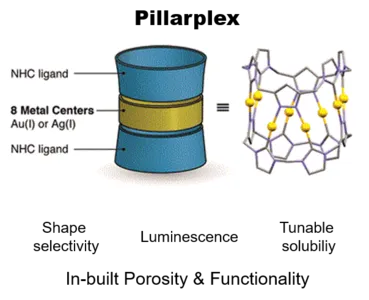Functional Porous Organometallocavitands in Network Materials – Proof of Concept
Organometallocavitands • functional building blocks • porous functional materials
A. A. Heidecker (a), A. Pöthig (a)
(a) Faculty of Chemistry, Technical University Munich, Lichtenbergstraße 4, 85784 Garching
To construct functional porous network materials, tubular organometallocavitands – so-called pillarplexes – are implemented as functional building blocks. The molecular coordination complexes bearing tailor-made macrocyclic NHC-ligands are exclusively shape selective hosts for linear molecules, show tuneable solubility via anion exchange reactions and the corresponding Au(I)-pillarplexes show intrinsic photoluminescence. In addition, mechanically interlocked molecules are created by introducing stoppers to the encapsulated linear molecules, leading to a template for coordination chemistry with a broad scope of functionality.
Detailed understanding of the structural self-assembly of pillarplexes are highly dependent on varying anions and their interactions. Selective modification of the pillarplexes and the combination with metal nodes leads to coordination polymers with the advantages of intrinsic porosity and functionality. Preliminary results highlight the concept to implement functionalized pillarplex molecules as linkers for network materials. By introducing functionalized stoppers, rotaxanes were formed and the rim of the macrocyclic NHC ligand was functionalized, further converting to the corresponding pillarplexes.
References
(1) P. J. Altmann, A. Pöthig, J. Am. Chem. Soc. 2016, 138, 13171-13174.
(2) P. J. Altmann, C. Jandl, A. Pöthig, Dalton Trans. 2015, 44, 11278-11281.
(3) P. J. Altmann, A. Pöthig, Angew. Chem. Int. Ed. 2017, 56, 15733-15736.
Interested in finding out more? Click here to learn more about this overarching COORNETs Phase II team and project.
